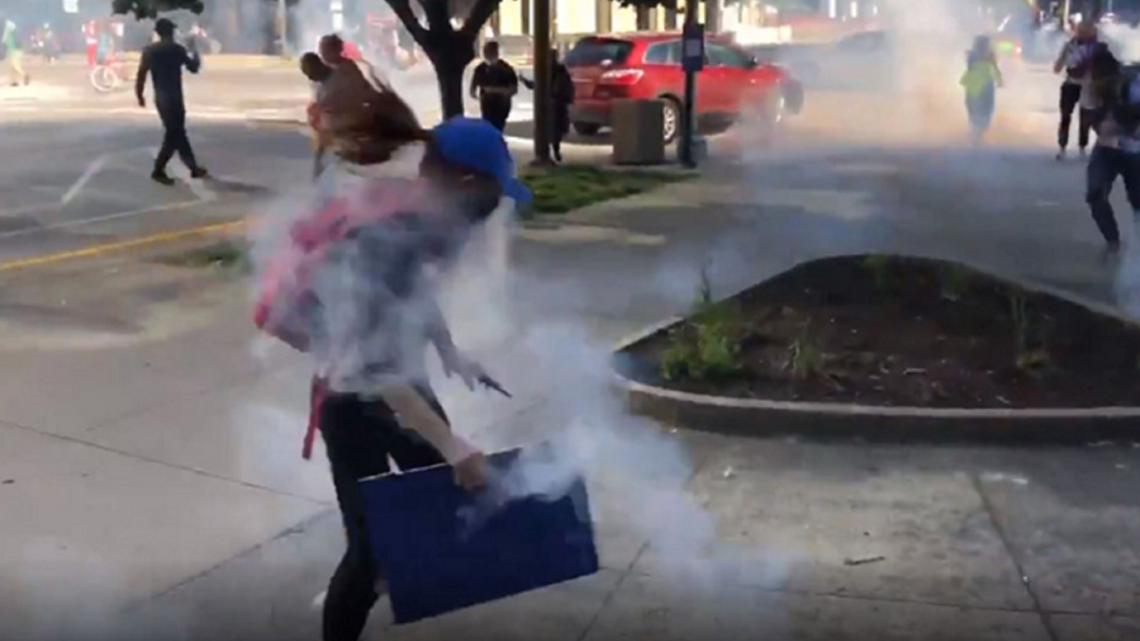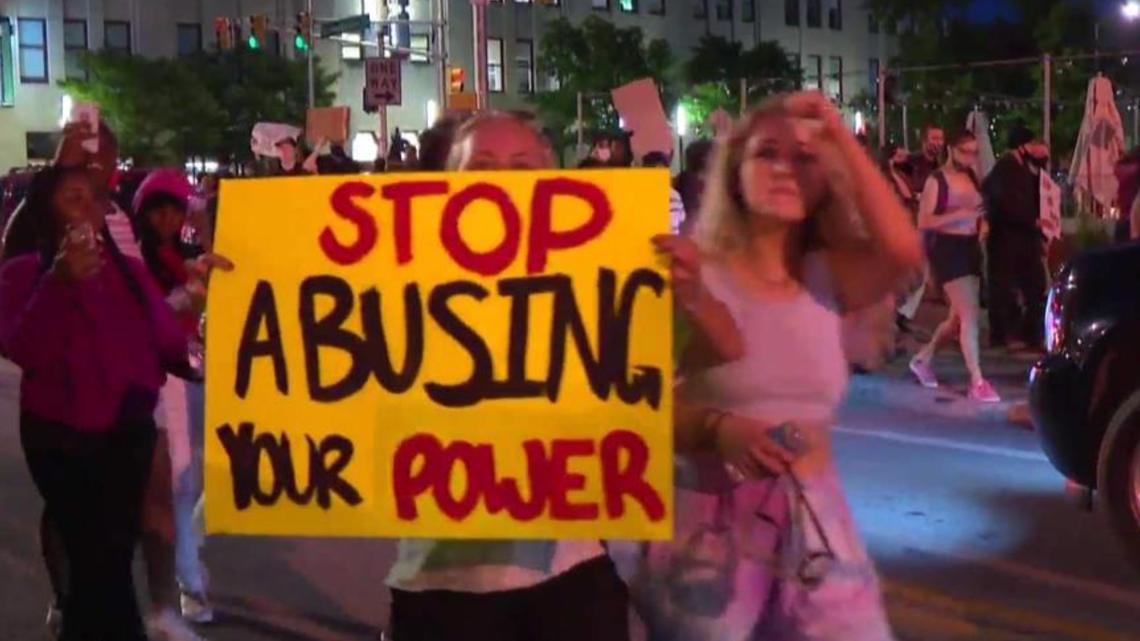INDIANAPOLIS — The Response Review Committee released a final report Friday on IMPD's response to the protests and civil unrest in Indianapolis last May 29 through June 1.
Among the issues cited in the report are a lack of planning, coordination and communication.
The report also said the pandemic had effects on IMPD's ability to respond and on morale and staffing:
"It is extremely important to bear in mind that this fateful weekend happened in the midst of the raging COVID-19 pandemic. City agencies including IMPD were dealing with the real challenges of the public health crisis and the strain on operations, morale and staffing. The City of Indianapolis was already dealing with an unprecedented challenge and this undoubtedly affected IMPD’s ability to respond to protests and crowds."
The report goes on to say that Indianapolis had never experienced demonstrations of the size and emotional level of the May 29 through June 1 protests. When looking at peaceful protests and then people making criminal acts, the "IMPD response failed to differentiate between these two very different groups of people, with highly unfortunate consequences."
"Indeed, there were repeated instances captured on video in which peaceful protesters tried to prevent violence by others and decried the vandalism they witnessed."
The report then blames IMPD for exacerbating tensions in the crowd and made it easier to some in the crowd to turn a peaceful protest against the officers. That also allowed for lawlessness, property damage and looting to more easily take place. However, the panel noted that the department changed its approach after the first two nights, which helped bring about more peaceful demonstrations.
The report said that despite all that, IMPD officers can't be solely blamed as they were "unprepared for and insufficiently trained to address a demonstration of this magnitude, were given insufficient direction by their superiors, and were unaccustomed to demonstrations for the purpose of protesting the police themselves."
In its conclusion, the panelists wrote, "However, a strategic and thoughtful approach from the outset, coupled with better communication–internal and external–might have avoided a great deal of physical and psychological damage to our city and its residents."


In response to the report, Indianapolis Fraternal Order of Police President Rick Snyder issued a short statement reading, "Our organization is now reviewing the report to better understand its contents and the perspectives that were included (and not included). We look forward to speaking further upon it in the coming days."
Review Committee recommendations
After interviewing officials, witnesses, IMPD documents and videos, the panel developed a list of recommendations:
- Improved training – Training of IMPD officers should be improved department-wide and at all levels, beginning at the cadet level with the curriculum approved by the Indiana Law Enforcement Academy (ILEA), which has been criticized for its outdated curriculum and methods of delivery. In the fall of 2020, Governor Holcomb commissioned a review by an outside police consulting firm that is anticipated to result in updated training curricula approved by the ILEA. The training provided to IMPD must include the protection of the First Amendment rights of those who demonstrate and engage in public protest. The training should include cultural competence, differentiation between lawful protesters and criminal actors, and de-escalation training.
- Internal planning and communication – IMPD should develop a clear strategic plan for each day of any such demonstration that respects the rights of legitimate protesters and calls for differentiation between them and those engaging in criminal activity. The plan should be clearly communicated each day to all officers reporting for duty. Though individual officer discretion is necessary in the field, it should be governed by clear orders from leadership that require protection of the rights of peaceful marchers and a separate focus on looters and those engaging in other criminal activity. There also should be better communication among agencies, including the Mayor's Office and the Marion County Prosecutor's Office.
- Use of de-escalation techniques rather than "disorder control" tactics – IMPD appears to have relied on tactics designed to control disorder rather than facilitate protected speech. The "Miami Model" (a more aggressive approach to protests used by Miami police in response to protests of the Free Trade Area of the Americas negotiations in 2003), referred to by at least one IMPD official interviewed, is not a recommended approach to managing First Amendment based demonstrations. This model, according to experts Edward Maguire and Megan Oakley, is "characterized by an aggressive, militarized approach to protest control." They indicate that while this approach may be appropriate in some rioting situations, it should not be used to address peaceful protests. As indicated elsewhere in this report, such an approach is likely to have a tendency to exacerbate, rather than relieve, tensions.
- Avoid excessive use of force – Officers should be clearly instructed on the appropriate use of force. Consistent with the agreement IMPD and the City have already reached with the American Civil Liberties Union, tear gas should not be used for the sole purpose of dispersing crowds. Further, pepper spray and pepper balls should not be used other than to control individuals who are in fact committing offenses.
- No encircling of crowds – the NYC/DOI described the actions of the NYPD, when encircling crowds/blocking egress, as "kettling" – defined in the research literature – and advised that it only contributes to heightened tensions and should not be a tactic that isemployed. The Panel endorses this recommendation in the case of IMPD as well.
- Avoidance of aggressive posture – Officers interfacing with such crowds should, if at all possible, be attired in "soft," or normal, police uniforms. Officers equipped with riot gear should be staged nearby in case of need but out of sight of the crowds.
- Improve outreach to community – IMPD needs a more robust outreach to the Indianapolis community, including real community policing and two-way communication with residents throughout the community. IMPD leadership must improve its current relationship with the community, which must start with active listening. The Panel is aware that IMPD leadership participates, for example, with the Greater Indianapolis Progress Committee's Race and Cultural Relations Leadership Network(RCRLN)on a regular basis. The Panel suggests that leadership seek specific input from the members of the RCRLN and also from the broader community on how it can revive trust among Indianapolis residents, and follow that advice. The community must be informed by IMPD about why it is taking certain action, and IMPD must be more transparent in its communications with community members. While communication is a two-way street, IMPD must realize that the responsibility for improving communication with the community is primarily its responsibility.


Mayor's response
Mayor Joe Hogsett's office released a statement in response to the report:
"During the weekend of May 29 through June 1, 2020, Indianapolis experienced one of the most significant events in the city’s history. As the murder of George Floyd led to sadness, anger, and turmoil across the country, Indianapolis witnessed unprecedented mass protests in support of racial justice. However, in this same moment, as emotions rose and tensions climbed, Indianapolis also experienced instances of rioting, looting, and violence. In the days following, it was clear we needed to understand more about the factors that contributed to such an event, about the response of law enforcement to the crisis, and about what Indianapolis could do different and better in the future. As a result, on June 22, 2020, I called for an independent review to 'look at evidence relating to the law enforcement response over the timeframe, evaluating officer adherence to departmental policies and providing recommendations on future police action.'
"Today, the panel's released report does just that. I want to thank the members of the review committee for their work, skill, and expertise in producing this report. The report is thorough, critical, and offers a series of recommendations rooted in best practices that offer our City and IMPD a roadmap moving forward.
"Since those days in late May and early June, IMPD has made a series of substantial changes, including reforms to IMPD's Use of Force policy, the creation of a Use of Force Review Board, civilian additions to the General Orders Board, and operational changes to the department’s response to large-scale gatherings. These adjustments have been consequential, and Indianapolis has seen over 150 protests without similar incident since June 1. However, our work will not stop. IMPD will continue to adapt and improve its policies and practices to best serve the needs of Indianapolis, leading through transparency and community-led, community-engaged policing. We value the conclusions made by this report, respect the tremendous amount of work that went into this important document, and will work to implement the recommendations."
IMPD Chief Randal Taylor response
"Just like many cities across the country, our community was impacted by two nights of riots in May. The recommendations in this report are critical of IMPD leadership’s actions during that time, as they were intended to be. But the men and women who serve in our neighborhoods every day were the ones faced with the unprecedented violence that struck the heart of our city, and ultimately, returned peace to the Mile Square. I remain grateful for their efforts.
"While violent unrest continued across several days in other cities, we adjusted our approach, and Indianapolis has since been host to more than 150 demonstrations without significant incident. We continue to take seriously our responsibility to protect the First Amendment rights of our community members.
"In June, I made a commitment that this police department would further its march toward progress. And that's exactly what we have done – modernizing our use of force policies, adding the safety measures and de-escalation tactics recommended by the ACLU to written policy for the Event Response Group, banning no-knock warrants, deploying body cameras, and adding new layers of civilian oversight. We have also taken steps to better communicate with our neighbors during the pandemic through such efforts as virtual community meetings and releasing critical incident videos in a timely manner following officer involved shootings. This report represents another opportunity for us to make adjustments that better protect our officers and the community members they serve.
"It is my hope that our dedication to accountability, transparency, and continuing to find ways to better serve our community helps to build trust and strengthen the police-neighborhood partnerships that create a safer Indianapolis."

